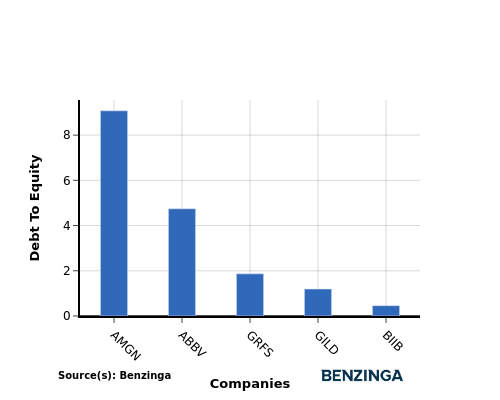Amidst the fast-paced and highly competitive business environment of today, conducting comprehensive company analysis is essential for investors and industry enthusiasts. In this article, we will delve into an extensive industry comparison, evaluating Biogen BIIB in comparison to its major competitors within the Biotechnology industry. By analyzing critical financial metrics, market position, and growth potential, our objective is to provide valuable insights for investors and offer a deeper understanding of company's performance in the industry.
Biogen Background
Biogen and Idec merged in 2003, combining forces to market Biogen's multiple sclerosis drug Avonex and Idec's cancer drug Rituxan. Today, Rituxan and next-generation antibody Gazyva are marketed via a collaboration with Roche. Biogen also markets novel multiple sclerosis drugs Plegridy, Tysabri, Tecfidera, and Vumerity. In Japan, Biogen's MS portfolio is copromoted by Eisai. Hemophilia therapies Eloctate and Alprolix (partnered with Sobi) were spun off as part of Bioverativ in 2017. Biogen has several drug candidates in phase 3 trials in neurology and neurodegenerative diseases and has launched Spinraza with partner Ionis. Aduhelm was approved as the firm's first Alzheimer's disease therapy in June 2021, followed by Leqembi in January 2023.
| Company | P/E | P/B | P/S | ROE | EBITDA (in billions) | Gross Profit (in billions) | Revenue Growth |
|---|---|---|---|---|---|---|---|
| Biogen Inc | 12.79 | 2.35 | 3.42 | 4.19% | $0.87 | $1.86 | -5.14% |
| AbbVie Inc | 28.59 | 19.06 | 4.40 | 15.4% | $5.42 | $9.62 | -4.92% |
| Amgen Inc | 17.63 | 20.63 | 5.29 | 22.74% | $3.26 | $5.17 | 5.94% |
| Gilead Sciences Inc | 17.61 | 4.51 | 3.53 | 4.96% | $2.5 | $5.16 | 5.42% |
| Vertex Pharmaceuticals Inc | 27.46 | 5.93 | 9.72 | 6.12% | $1.21 | $2.18 | 13.52% |
| Regeneron Pharmaceuticals Inc | 20.51 | 3.51 | 6.96 | 4.08% | $1.2 | $2.75 | 10.53% |
| Moderna Inc | 24.97 | 1.61 | 2.71 | -7.71% | $-1.64 | $-0.41 | -93.08% |
| BioNTech SE | 4.78 | 1.04 | 2.28 | -0.95% | $-0.38 | $-0.37 | -94.75% |
| Biomarin Pharmaceutical Inc | 155.13 | 3.17 | 6.89 | 1.19% | $0.1 | $0.47 | 11.52% |
| Incyte Corp | 32.23 | 2.48 | 3.37 | 4.42% | $0.3 | $0.89 | 4.74% |
| Neurocrine Biosciences Inc | 59.60 | 5.59 | 6.43 | 5.4% | $0.13 | $0.44 | 19.7% |
| United Therapeutics Corp | 12.42 | 1.90 | 5.13 | 4.92% | $0.36 | $0.53 | 27.76% |
| Exelixis Inc | 40.42 | 2.55 | 3.84 | 3.19% | $0.08 | $0.45 | 12.02% |
| Grifols SA | 43.37 | 0.86 | 0.78 | 1.02% | $0.25 | $0.62 | 7.81% |
| Average | 37.29 | 5.6 | 4.72 | 4.98% | $0.98 | $2.12 | -5.68% |
When closely examining Biogen, the following trends emerge:
-
The stock's Price to Earnings ratio of 12.79 is lower than the industry average by 0.34x, suggesting potential value in the eyes of market participants.
-
The current Price to Book ratio of 2.35, which is 0.42x the industry average, is substantially lower than the industry average, indicating potential undervaluation.
-
Based on its sales performance, the stock could be deemed undervalued with a Price to Sales ratio of 3.42, which is 0.72x the industry average.
-
The company has a lower Return on Equity (ROE) of 4.19%, which is 0.79% below the industry average. This indicates potential inefficiency in utilizing equity to generate profits, which could be attributed to various factors.
-
The company has lower Earnings Before Interest, Taxes, Depreciation, and Amortization (EBITDA) of $870 Million, which is 0.89x below the industry average. This potentially indicates lower profitability or financial challenges.
-
Compared to its industry, the company has lower gross profit of $1.86 Billion, which indicates 0.88x below the industry average, potentially indicating lower revenue after accounting for production costs.
-
With a revenue growth of -5.14%, which surpasses the industry average of -5.68%, the company is demonstrating robust sales expansion and gaining market share.
Debt To Equity Ratio

The debt-to-equity (D/E) ratio is a measure that indicates the level of debt a company has taken on relative to the value of its assets net of liabilities.
Considering the debt-to-equity ratio in industry comparisons allows for a concise evaluation of a company's financial health and risk profile, aiding in informed decision-making.
In terms of the Debt-to-Equity ratio, Biogen can be assessed by comparing it to its top 4 peers, resulting in the following observations:
-
In terms of the debt-to-equity ratio, Biogen has a lower level of debt compared to its top 4 peers, indicating a stronger financial position.
-
This implies that the company relies less on debt financing and has a more favorable balance between debt and equity with a lower debt-to-equity ratio of 0.46.
Key Takeaways
Biogen's low PE, PB, and PS ratios suggest that the company's stock is undervalued compared to its peers in the biotechnology industry. This indicates potential for future growth and a favorable investment opportunity. However, Biogen's low ROE, EBITDA, gross profit, and high revenue growth indicate that the company may be facing challenges in generating profits and managing expenses. Further analysis is required to understand the reasons behind these trends and their impact on Biogen's overall financial performance.
This article was generated by Benzinga's automated content engine and reviewed by an editor.
Edge Rankings
Price Trend
© 2025 Benzinga.com. Benzinga does not provide investment advice. All rights reserved.
Trade confidently with insights and alerts from analyst ratings, free reports and breaking news that affects the stocks you care about.